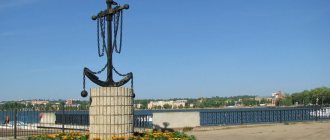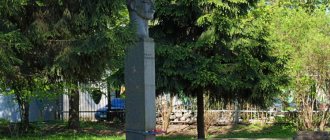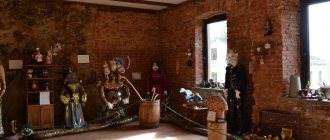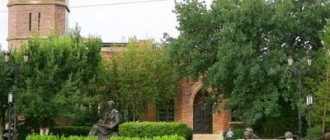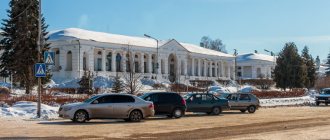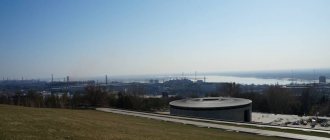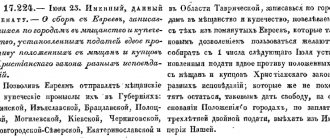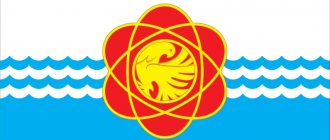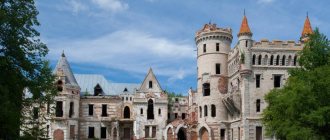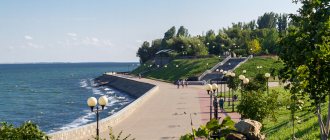A little about the city
The city of Belev is practically the same age as Moscow - the first mentions of it were preserved in chronicles dating back to 1147. In the 4th century it was under the rule of Lithuania and for some time was the center of an appanage principality. It was an important strategic point within the Russian state.
In the 18th century, Belev lost its military significance and turned into a quiet provincial town, which it remains to this day. Despite the small territory occupied by the city, there are many interesting and memorable places: churches, monasteries, museums. We present descriptions of the sights of Belev and photos in this review.
Belev is one of the most ancient cities of the Russian state. Due to the prevailing circumstances, he always played a prominent role in the struggle of the Russian people for their freedom and independence. More than once he had to meet numerous enemies under his walls and give them a worthy rebuff.
For many centuries this ancient city stood faithfully guarding the southwestern outskirts of the Russian land.
Originating in a remote corner of the possessions of the East Slavic tribe of Vyatichi, Belev first belonged to the Kyiv and Chernigov princes, and then was included in the Moscow principality.
In the 17th century, Belev suffered the heavy burden of the Polish-Lithuanian intervention. Under the walls of the city, rebel peasants under the leadership of Ivan Bolotnikov fought with the tsarist troops.
Antique monuments, documentary sources, and the former names of individual places and settlements, rivers and rivulets, tracts and ravines, preserved in people’s memory, remind us of these long-ago times, of the heroic events of the distant past that have become part of history.
The time of Belev's founding is not known exactly. The first mention of it is found in the Ipatiev Chronicle in 1147. In 1437, we again meet Belev on the pages of Russian chronicles in connection with the attack on the city by one of the khans of the Golden Horde, Ulu Muhammad.
The lands located along the upper reaches of the Oka River, and in particular the territory of the modern Belevsky district, began to be populated in ancient times. Archaeological excavations in Belyov, Doltsy, Fedyashevo, Voronets, Zhabyn, Snykhov, Kazarka showed that people of the Neolithic era lived in these places. Already in the third - early second millennium BC. e. On the territory between the modern cities of Belyov and Serpukhov, there were camps of tribal society tribes engaged in hunting and fishing. A unique archaeological culture, known as Belyovskaya, developed here. It is characterized by pottery with diamond-pitted designs, flint tools with massive knife-like blades, stone axe-shaped tools and narrow long “daggers”. Traces of ancient settlements remain in the sites and settlements on the territory of the Belyovsky district.
The emergence of the city of Belev is associated with the general course of socio-economic development of the East Slavic tribes. In the first millennium AD, the territory of the modern Belevsky district was part of the lands of the East Slavic tribe of Vyatichi. Their main occupation was agriculture. Along with this, they were engaged in cattle breeding, fishing, airborne fishing, hunting and animal hunting, in particular squirrel hunting.
In the 11th-12th centuries, cities emerged in the land of the Vyatichi - fortified centers of craft production and trade. One of them was Belev.
There are several hypotheses about the origin of the names of the city of Belev. One of them claims that the word “belev” is of Finnish origin. However, the Vyatichi, who lived on the territory of modern Belev, were never conquered by the Finns, and their culture did not have any influence on the Vyatichi. So this hypothesis is unlikely.
Other researchers have noted that the root in the word “belyov” is “bel,” from which the derivative in modern Russian is “white.” The ancient Slavs enjoyed special respect and veneration for the heavenly bodies, which were personified with the concepts of clarity, purity, and whiteness. One of the most important gods among the Slavs was Belbog, symbolizing light and life. The white color symbolized youth and light among the Slavs. The word “bel” was also used to define the characteristics of various objects, names of cities, towns, rivers, lakes (Belgorod, Beloozero, Beloberezhye, etc.); white place - land free from taxes; a white man is free and not subject to anyone.
According to the largest Belyov local historian of the 19th century, Archpriest of the Resurrection Church M.F. Burtsev, Belyov received its name from the word squirrel, since the forests surrounding the city abounded with this animal, and the squirrel skins themselves “served as an object of exchange and sale for the local population. It is possible that the city was originally called Belovekshesk (veksha - squirrel), and as a result of further abbreviations it acquired the modern name Belev.
The place where Belev arose was located on a high and steep bank of the river. Okie. By fortifying this place with an artificial fortification, the Vyatichi received a fairly powerful fortress and, if necessary, could successfully defend themselves from the enemy.
In the 10th century the lands of the Vyatichi, located along the upper reaches of the Oka and its tributaries, became part of. Old Russian state.
Svyatoslav and other Kyiv princes more than once had to “pacify” the Vyatichi, with great difficulty keeping them in obedience. The upper reaches of the Oka, including the territory of the modern Belevsky district, repeatedly turned into an arena of fierce clashes between the princely warriors and the Vyatichi. It is possible that the names of the rivers Serebryanka, Velya-Grivenka and Rezanka, about which there is information in scribe books and which are indicated on maps of Belevsky district, originate from the times when the Kiev princes imposed tribute on the Vyatichi.
When the Old Russian state collapsed, Belev became part of the Chernigov principality. In 1246, after the death of the last Chernigov prince, Mikhail Vsevolodovich, the Chernigov principality, in turn, broke up into smaller fiefs. One of these inheritances was the Novosilsk principality, which included the cities of Odoev and Belev.
Novosilsk Principality in the 14th century.
In 1368, one of the Novosilsk princes, Roman Semenovich, swore allegiance to the Moscow Grand Duke Dmitry Donskoy, and participated with his squad in the Battle of Kulikovo in 1380 and a number of other battles on the side of Moscow. For this, the Principality of Novosilsk was subjected to a devastating attack by the Grand Duke of Lithuania Vytautas, who captured Belev and annexed it to his possessions. Fleeing from the Lithuanians. Roman Semenovich left Novosil and moved to a safer place, surrounded on all sides by forests, Odoev. However, in 1407 Odoev was also captured by Lithuania and annexed to its possessions.
After the death of Roman Semenovich, Lithuania seeks to strengthen its influence in the Russian lands it captured, located along the upper reaches of the Oka, to secure Odoev and Belev, and to drive a wedge into the relations between the Odoev principality and the Moscow state. To this end, counting. To enlist the sympathy of the Odoev princes and make them their faithful vassals, the Lithuanian princes in 1468 gave the city of Belev and the volosts to the brother of the Odoev prince Lev Romanovich Vasily Romanovich as an appanage reign, subject to “faithful service” and acceptance of the union. This is how the Belevsky appanage principality arose, one of the three (Odoevsky, Novosilsky) that existed in ancient times on the territory of the modern Tula region. Lithuania was interested in the existence of small, fragmented Russian principalities, since this weakened the Moscow state and made it easier to fight it.
Belevsky appanage principality in the 14th century.
The Belevsky appanage principality, small in size, occupied an insignificant part of the territory of modern Tula and Kaluga regions. The eastern neighbor of the principality was Odoev, in the north its border passed near Kozelsk, in the south - near Bolkhov, in the west - not far from Zhizdra.
Already the first Prince of Belev, Vasily Romanovich, did not fulfill the conditions put forward by Lithuania. However, civil strife arose more than once between subsequent generations of the Belyov princes over their political orientation. Ivan Vasilyevich, one of the representatives of the younger generation of Belyov princes, put an end to this. In 1490, he went over to the side of Moscow, and in 1493, taking advantage of the fact that his brother Andrei Vasilyevich was absent in Belyov, he and his squad attacked his other brother Vasily, captured him and his boyars and forcibly forced them to “kiss the cross” in loyalty to Moscow. After this, Ivan Vasilyevich attacked Andrei’s estate and declared it his property. To the claims made by Lithuania, the Grand Duke of Moscow Ivan III replied that Belev and Odoev were from Moscow from time immemorial.
The broad masses saw in Moscow the only defender of the national interests of the Russian people and constantly strived for unification with Russia. The most far-sighted representatives of Belyov's appanage princes could not help but take this into account in their foreign policy. In 1494, completing the unification of the fragmented Russian lands into a single centralized state.
Ivan III forever annexed Belev to Moscow. From that time on, the Belyov princes became servants of the Moscow sovereigns. At the head of the Belyov squads, they were sent to Smolensk against the Poles and to the Tula defensive line against the Tatars. The last of the Belyov appanage princes, Ivan Ivanovich, in 1531 was the first commander of a guard regiment on a campaign against Lithuania.
In 1558, Ivan the Terrible, strengthening a centralized state with a single autocratic power, exiled Ivan Ivanovich to Vologda and imprisoned him in a monastery, where he died, and included the city among the lands taken into the oprichnina and intended for “disposal,” i.e. maintenance of the royal servants. “And the Belyov princes were exhausted, and Belyov, the Tsar and Grand Duke Ivan Vasilyevich, of all Rus', took over their patrimony,” it is written about this in the chronicle. In the same year, Ivan the Terrible came with his guardsmen to Belyov, as to his patrimony. The Belevsky appanage principality existed for a little over 100 years. The princes had the right to mint their own copper coins "pulas". Such money was found during excavations; on it you can read: “Belyov money.”
The return of the upper Oka basin was of great importance for the Russian state, as it gave great advantages in the defense of its entire southern outskirts.
Located on the southwestern outskirts of the Russian state, Belev was repeatedly attacked by the Tatars and Lithuania.
In 1437, Khan of the Golden Horde Ulu Muhammad, expelled from the Horde by his rival Edigei, fled to Russian lands with three thousand of his followers. In the fall of the following year, he captured Belev with the townsman settlements adjacent to it, hoping to sit out here and then resume the fight for the khan's throne. Having settled in the city, the Tatars began to subject its surroundings to continuous plunder.
When winter began, the Tatars built a fortress out of brushwood and thick ice, covered it with snow and filled it with water, turning it into a reliable stronghold in case of a surprise attack.
To the proposal of the Grand Duke of Moscow Vasily Vasilyevich the Dark to leave Belev, Ulu Muhammad refused. Then Vasily the Dark sent an army against him under the command of his cousin Dmitry Shemyaka. However, Shemyaka, who was his brother’s political opponent in the struggle for the Grand Duke’s throne, did everything in his power to doom this campaign to failure and to stir up the masses against him. On the way from Moscow to Belev, this “valiant” army was “distinguished” by subjecting the peaceful Russian population to robbery and violence.
On December 4, 1438, Shemyaka’s army approached the ice fortress of Ulu Muhammad. After a failed attempt at peace negotiations, the battle began. The chronicle says: “In the summer of December 5, 946 (1438), the Russian Grand Duke fought on Belov with Tsar Makhmet”; it ended in the defeat of the Russian troops.
The chronicle of 1472 mentions the invasion of the Crimean Khan Akhmat into the upper reaches of the Oka and his appearance under the walls of Belev. In 1507 and 1512, the Crimean Tatars again attacked the Belevsky and Odoevsky principalities and subjected them to ruin. Karamzin in the “History of the Russian State” reports about this event: “in May 1512, the Khan’s sons Akhmat and Burnash Girey with numerous gangs broke into the Belevsky, Odoevsky regions, committed crimes like robbers, and fled when they learned that Prince Daniil Shchenya was hurrying them meet in the field."
In 1536, the Azov Tatars again tried to attack Belyov. Belevsky governor Levshin, having learned about the approach of uninvited guests, came out to meet them and in a bloody battle near the village of Temryanya, 7 km from Belev, defeated them.
The period of the Polish-Lithuanian intervention of the 17th century was especially devastating for Belev. Occupying a border position, it was among the most devastated territories of the Moscow state. In 1611-1615. the city and the villages surrounding it were almost completely destroyed. The surviving townspeople and peasants, left without shelter and a piece of bread, turned into beggars and fed on alms around the Belyov churches and monasteries.
Scribe books tell about this difficult time for Belev, as for many other Russian cities. Each page of them is evidence of the disasters and suffering that the Russian people had to endure during these years: “and there are 46 people who are poor from the war, and now there are 46 people in the Belev settlement and in the district named after Christ, and they also have empty places. Yes, there are 42 empty places that people have beaten from the Lithuanian people, and in total there are 88 empty townspeople places.”
In 1613, the Lithuanians burned the fort. Belevsky governor Gagarin reported to Moscow: “They took the Belevsky prison, and he and the nobles and boyar children sat out in the city.”
In 1615, Belev and its environs were attacked by the Polish hetman Lisovsky, but was defeated by Russian troops led by the national hero D. M. Pozharsky and fled in the direction of Przemysl and Aleksin.
In 1618, the city was attacked by the Polish governor Chaplinsky, but was repulsed by the Belevsky governors Levshin and Afremov, who died in this battle.
In the XVI-XVII centuries. Belev was part of the defensive line of the Russian state - the abattoir, so much attention was paid to its strengthening. Even under the first Belevsky appanage prince Vasily Romanovich, an oak fortress was built with towers, cuttings and loopholes, with an earthen rampart on all sides, two gates and a hiding place facing the Oka.
Built in the 15th century, the wooden fortress fell into disrepair by the end of the 16th century. Taking into account the special position of Belev in the defense of Moscow from Polish-Lithuanian and Tatar attacks, the tsar made a decision to build a new fortress in Belev. For this purpose, Prince Solntsev-Zasekin is sent there. In 1592 the fortress was built.
The fortress is an oak city, logged, built on a high mountain on the left banks of the Oka and Belyovka rivers and occupied an area of more than 4 hectares. The fortress had 11 towers, which were called: Vasilyevskaya, Tainitskaya, Spasskaya, Proezzhaya, Polevaya, Srednyaya, Lobovskaya, Mironositskaya, Moskovskaya, Deaf, Torture.
The walls were 4 meters thick. A deep ditch was dug parallel to the fortress wall, over which a bridge was thrown. There were buildings inside the fortress: to the right of the Tainitskaya tower was a prison, to the left of it was a prison where thieves were imprisoned, and even further to the left stood the Assumption Cathedral. Near the Middle Tower there was the office of the governor - the head of the fortress and commander of the Belyov garrison. On the left side of the fortress there were Lantratsky mansions - the local administration of all civil affairs. From the Field Tower to the left, on Sechina Mountain, a staircase was built, from which the road went to the Oka River, as well as to the bridge over the Belyovka River. From the Moscow road tower there was a big road (bolshak) to Moscow and it was called the Great Moscow Road.
The fortress flowed around the then existing Belevka River on two sides, on the third side - the Oka, and on the fourth - it was protected by a wall and an artificial deep ditch. In 1620, the fortress was strengthened with a new fort and rampart.
In the painting of 1643 Fr.
In 1636-1637 In terms of its importance and the number of military men (461 people), Belevskaya Fortress ranked third among the cities of the Tula region (after Dedilov and Tula).
Since 1640, in connection with the movement of the defensive line of the Russian state to the south, to the Belgorod line, from Belyov, as well as from other cities of the Tula region, a gradual ebb of military personnel begins. In 1640, 13 Cossacks and 10 archers were transferred from Belev to Chuguev; in subsequent years, the outflow of military personnel from the city increased. If in 1651 the Belevsky garrison numbered 321 people, then in 1669 - 277, and in 1678 - 212.
The fortress itself is losing its former military significance and is being destroyed. In the painting of 1694 Fr. In 1719, during a big fire in the city, the fortress with all 11 towers was destroyed, the Church of the Assumption, offices, a prison, and a prison burned down. 2 churches in the monastery burned down. 9 parish churches, almshouses, 295 residential buildings, shops and barns, taverns and blacksmiths burned down. The fire destroyed the zemstvo courtyard, the living room and the lace courtyards.
There were two more big fires in the 18th century - in 1763 and 1772. The most severe fire was in 1801 - all of Zavyrye and 450 more houses burned down.
Belev of the 16th-17th centuries is a typical feudal ancient Russian city, built and expanded without any plan. The main fortified part of the city was the oak fort (fortress). Around it there were huts of the urban, so-called townspeople, and numerous wooden churches.
The population of the city was very heterogeneous: military personnel and artisans, traders and clergy, area sextons, shipyards and peasants.
In Belyov there were many small shops selling mainly products of local artisans and a variety of foods typical of that time: honey, rolls, kvass, pies, hemp oil, sweets, fish, etc. The shops formed shopping arcades - Kalash, bread, meat, etc. At every step there were kvass houses, taverns, malt and beer breweries, wax slaughterhouses and other small craft establishments.
The townspeople engaged in crafts typical of ancient Russian cities. Among the local population there were many carpenters, shoe makers, tailors, potters, kvass makers, candle makers, kalachniks, coopers, pastry makers, sheepskin makers, etc. But there were also many military people in the city - archers, Cossacks, gunners, zatinshchiki, collar workers.
Around the city there were numerous settlements: Streletskaya, Pushkarskaya and Cossack, inhabited by military personnel; The lowest one is along the banks of the Oka, below the fortress, inhabited by poor fishermen; Sub-monastery, inhabited by peasants and artisans who belonged to the Spaso-Preobrazhensky Monastery. The largest settlement, Zavyrskaya, made up the second part of the entire city and was separated from the rest of it by the Malaya Vyrka River. Under Boris Godunov, Zavyrye was considered palace property, and under Mikhail Fedorovich it was assigned to Belyov.
The majority of the city's townspeople were engaged in small crafts and trade.
Life was much more difficult for the peasants of Belyovsky district, who were in cruel bondage to the sovereign's servicemen, large and small patrimonial landowners and children of the boyars.
In the XVI-XVII centuries. the final enslavement of the peasants takes place, accompanied by the seizure of their lands by the feudal lords, the brutal exploitation of peasant labor, and the strengthening of the economic and legal power of the feudal lords over persons, labor and property. peasant. Each peasant was entered into the scribe books and assigned to a specific owner.
All the best lands were under the lord's plowing, and peasant arable land, as a rule, was located in the worst areas - wastelands, fallow lands, wetlands and forested areas. There were less than 5 thousand acres of land under peasant arable land. But life was easy for large military men, nobles, and children of boyars, who were repeatedly “granted” by the Moscow tsars for “faithful service” with many lands, estates, lands and serfs. The steward Bezobrazov alone had from 400 to 500 acres of land in Belevsky district.
The owners of estates in the district were 354 nobles and boyar children, 9 stolniks, 1 boyar, not counting a large number of smaller service people. They owned 16 villages, more than 130 villages with a population of over three thousand peasants and about 25 thousand acres of land.
Large estates in Belyov and the district were monasteries and churches. The princes patronized them in every possible way, finding reliable support in them. The first Belyov appanage princes founded the Spaso-Preobrazhensky Monastery and, having chosen it as the place of their burial, assigned their rich estates to it for eternal possession. According to the census book of 1694 “Spassky Monastery for the abbot with the brethren in Belev and Belevsky district on the rent of the river. Oka with fishing, and with transportation, and with beaver ruts, and with lakes from the sources from the Likhvinsky border on both sides to the Mtsensk border. Yes, in the Spaskov Monastery in the city of Belyov on the river on Malaya Vyrka there is a windless mill.” The Holy Cross Monastery owned large lands.
The Belevsky monasteries owned about two thousand acres of land, a number of villages and hamlets. The former names of some of these villages, now not preserved in the memory of the population, indicate that they were monastic possessions. For example, village Lamonovo in the XVI-XVII centuries. belonged to the Spasopreobrazhensky Monastery and was called Chertsovo (chernets means monk). In Belyov there was a Podmonastyrskaya settlement, where peasants lived who also belonged to the Spaso-Preobrazhensky Monastery.
In addition to monasteries, there were 14 churches in Belyov, not counting more than three dozen churches located in the district. All of them were maintained at the expense of the state and the population and had land and other holdings.
Since the 17th century, a new period began in the history of the Russian state, characterized by the strengthening of feudal-serf oppression, the formation of an all-Russian market, the development of small industry and manufactories, and the emergence of bourgeois relations. Naturally, Belev did not remain aloof from the changes that were taking place in the economic and political structure of Russia.
Having lost its military-strategic significance, Belev remains the most significant town in the Tula region, and since the 18th century it has become a major trade and merchant center of the Tula province with a fairly developed network of craft and small industrial establishments. Belev retained this meaning until the 60-70s of the 19th century.
Old Belev Street
The craft is developing not only in the city, but also in villages, among serfs. Back in the second half of the 17th century, more than 200 arshins of homespun cloth were delivered annually to the Moscow courtyard of steward Bezobrazov from all his villages located in various districts, and the largest amount of cloth came from Belevsky district, where it was produced at home by the manual labor of serfs and then in in the form of rent it was given to the feudal landowner.
Administratively, Belev in 1708 was assigned first to the Smolensk and then to the Kyiv provinces. In 1766 it was part of the Belgorod province. In 1777, with the establishment of the Tula governorship, it was included in its composition as a district city. In 1797, after the formation of the Tula province, the importance of Belev as a district center did not change.
In 1778, a coat of arms was approved for the city, which represented a sheaf of barley in a blue field with a flame coming out of it - the emblem of brewing, which was very developed in Belev until 1801, when during one of the big fires almost all breweries were destroyed.
Coat of arms of the city of Belev
The plan of the city of Belev was approved in 1779, but only after the fire of 1801, which destroyed a significant part of the city, the newly built streets received a certain system.
Developing in the 18th and first half of the 19th centuries. As a significant trading center and marina in the upper reaches of the Oka, Belyov becomes the largest city in the Tula province after Tula. At the beginning of the 19th century. it conducts a brisk trade in bread, agricultural products and raw materials. During this period, the central streets of the city - Bolshaya Kozelskaya and Kaluzhskaya - were lined with large stone houses that belonged to merchants and nobles. At the end of the 18th century. (1792) the city had over 5 thousand inhabitants, in the second half of the 19th century - 10 thousand, and by 1914 - 14 thousand.
The industry that developed at this time in Belyov was mainly associated with the processing of agricultural products and raw materials. In 1792, the city had 18 tanneries, 3 lard refineries, and several mills. In the 30s and 40s of the 19th century, there were several factories engaged in the production of ropes for river ships and ropes for sewing sacks, several hemp spinning and hemp carding factories, cloth factories, flour mills, breweries, oil mills and other enterprises.
These were small industrial establishments of various types with imperfect equipment, low productivity and a small number of workers. A relatively large cloth factory for that time, owned by court councilor Pavlov, was equipped with one machine for carding wool, driven by horses, and five spinning machines with manual drive. Forty artisans employed at the factory, on 12 machines, annually produced 13 thousand arshins of white cloth, which went mainly to the Moscow Commission for the Supply of Troops with Cloths.
At the tannery of the merchant Semin, with two machines for crushing bark and 30 fermentation vats, 10 workers and 1 master worked. The plant produced plantar and other leathers worth several thousand rubles a year. Four lard factories, each of which had one laborer and one foreman, produced about 7 thousand pounds of pure lard per year. These 4 factories processed about 10.5 thousand pounds of raw beef lard per year.
On the territory of Belyovsky district there were 6 oil mills with 14 workers, more than a dozen wool workers, several grain grinders and about 70 mills, which employed a total of over a hundred workers. The products they produced were mainly exported.
The development of Belev as a trading point was facilitated by its favorable geographical location. Located on the border between the northern provinces of Central Russia and its southern black earth regions, he was an intermediary in all trade transactions and relationships between the Oryol, Kursk, Voronezh, Tambov and other southern provinces of Russia, as well as Ukraine with Moscow, Nizhny Novgorod, St. Petersburg and Riga.
The Belevskaya river pier was the southernmost and essentially the only large pier in the upper reaches of the Oka, conveniently located for the main grain-producing provinces. Only through it could agricultural products, bread and raw materials be sent from these provinces. Often, goods were delivered to Belev by land, and here they were loaded onto barges and sent further north. The transport significance of the Belevskaya pier was especially great before the construction of the Dankovo-Smolensk branch of the Ryazan-Ural railway.
View of Belev from the Oka.
Photography from the early 20th century.
Belyov merchants conducted a lively trade in silk and woolen fabrics not only in Belyov, but also in other cities: they purchased hemp, bread, oil, wax, lard, yuft and other agricultural products and raw materials, loaded these goods in Belyov on barges, plows and along the Oka they were sent to Moscow, St. Petersburg, and from there to Riga and abroad. Many merchants had their own auctions at the St. Petersburg port, where they sold these goods.
A peculiar form of trade, very developed among the population of Belyov at the end of the 18th and first half of the 19th centuries, was marquisting - trade in products and military items in the army during military campaigns and maneuvers.
Museum of Local Lore
We suggest you start getting acquainted with the city by visiting the Museum of Local Lore, which was founded in 1910 as a museum of educational and visual aids. The basis of the exhibition was made up of items that were purchased at the agricultural exhibition by the Zemstvo Duma of Belev. A series of portraits of Russian emperors and princes was presented by the artist P. V. Zhukovsky, the son of a famous poet. He also became the first trustee of the museum, where by that time works by Repin, Aivazovsky, Savrasov, and Shishkin were already exhibited.
After Zhukovsky's death (1912), the museum received his name. After the revolution, the collection was expanded and the museum was given the status of a local history museum. In 1941, the building in which the exhibition was located was destroyed by fire. Some exhibits were lost. Only in 1960 was it decided to reopen the Local History Museum in the city. Today it is one of the main attractions of the city of Belev in the Tula region.
The museum today occupies two floors in a 19th-century merchant mansion. Its main fund consists of more than 18 thousand exhibits, which is replenished every year with new finds. There are departments here that are dedicated to the history and nature of the city, as well as art.
Spaso-Preobrazhensky Monastery
One of the most popular attractions in Beleva. The Spaso-Preobrazhensky Monastery is the only surviving religious building of the 16th century in the Tula region. It was founded by local princes in 1525. During its heyday it was a rich and large monastery. His possessions included the estates of appanage princes, which, by order of Tsar Ivan IV, were transferred to the monastery, as well as lands on the banks of the Oka River, more than a hundred kilometers long, with lakes and tributaries. The monastery owned thirteen villages with peasants and land.
In 1921, the monastery was closed by the new authorities. The domes and utensils were looted, some rooms were converted into residential areas. Today, the dilapidated monastery is being restored, although not very quickly.
The monastery has preserved the Vvedenskaya Church, the Transfiguration Cathedral, and the Church of Metropolitan Alexy. The necropolis contains the remains of honorary citizens. The relics of St. Nikephoros, who is especially revered by local residents, are preserved here.
What to see in Belyov
Like many provincial Russian towns, Belyov boasts a colorful history but modest modernity. Little has been preserved from the past in reality, and even in the memory of the residents. The place remains unchanged and authentic - the high bank above the spectacular bend of the Oka, marked by monastery churches on the old site.
The historical center of the city is two almost merged monasteries, Spaso-Preobrazhensky and Krestovozdvizhensky. Recently dilapidated, they are slowly being restored. Formally, the Holy Cross Monastery no longer exists - in 2010 it was decided to join the neighboring Spassky Monastery. But this is only on paper, and on the banks of the Oka everything remains the same. For almost three hundred years, two cathedrals, two bell towers and two monasteries have stood side by side, separated by a low wall and an orchard. The Holy Cross has always been feminine, and the Savior of Transfiguration has always been masculine. Now they seem to have finally grown together, but each has its own, separate story. Also in the Belevsky district on the Oka River there is the Holy Vvedensky Makarievsky Zhabynsky Belevsky Monastery (Pustyn).
Among the city brands, apple marshmallow stands out, no less legendary than Tula gingerbread. Three Russian cities were famous for pastila: Kolomna, Rzhev and just Belev. Once upon a time, it was made in almost every Belevsky house that had a garden, from Antonovka carrion: the pulp of baked apples was beaten together with sugar and egg whites, then rolled into a roll. The right marshmallow is made handicraft, at home, and also in the village of Bogdanovo near Belev, at the Belevskie Sladosti enterprise. It’s really worth a try, if only because the vast majority of people have no idea what Russian pastila should really be like. There is also the opportunity to visit the factory founded by A. Prokhorov. Tourists dress in white clothes and enter the “workshop” for making sweets. They witness the production of marshmallows at every stage: from loading raw materials to baking sweet layers. At the end there will be a master class for those interested (to be agreed upon upon request).
However, Belev has historically been a place that everyone passes through. Empress Elizaveta Alekseevna, the widow of Alexander I, even died here while passing through from Taganrog, which became the most important event in local history for the entire 19th century. In addition, through Belev, Pushkin proceeded to the Caucasus (this is marked by a romantic-looking bust installed in front of a very shabby Soviet-built house), and Gogol and Leo Tolstoy to Optina Pustyn. Lev Nikolaevich passed through Belyov more than once: having set off on his last journey from Yasnaya Polyana, he dined at the buffet at the Belyovsky station. The station is still the same, a commemorative plaque hangs on it, but the lunch can only be repeated symbolically - everything inside was completely rebuilt after the war.
Turgenev also wandered around Belyovsky with a gun, but no stray hare ran away from him towards the town, so there was no reason to erect a monument. Zinaida Gippius, born in Belyov, is also not noted.
Zhukovsky is considered the main Belevsky writer and historical character. Near Belev was his favorite estate, Mishenskoye, where Vasily Andreevich spent his childhood and then wrote many poems. The poet’s drawings depict beautiful local and city landscapes - subtle, transparent and romantic. The city museum of local history is named after Zhukovsky’s son, Pavel Vasilyevich, an academician artist who founded the first city museum at the beginning of the 20th century.
Belev is one of the most promising cities in the Tula region in terms of tourism development. It is located on the banks of the Oka River in one of the most picturesque and ecologically clean places in the region, and the potential of the territory’s tourist resources allows the development of such types of tourism as military-patriotic, cultural, educational, religious, gastronomic, industrial, as well as hunting and fishing.
Church of the Nativity
One of the most famous sights of Belev in the Tula region is the ancient Orthodox Church of the Nativity of the Blessed Virgin Mary. It was founded at the beginning of the 18th century. The temple building was one of the first stone structures built after the severe fire of 1719.
Over its long history, it was reconstructed several times, but the work was partial and local in nature. Vivid examples of later buildings include the bell tower, built in 1876 in the pseudo-Russian style. During another reconstruction of the temple (early 19th century), two limits appeared. They are consecrated in honor of Sergius of Radonezh and Nicholas the Wonderworker.
The cathedral was closed in 1930, but was reopened quite quickly - in 1943. From that moment on, he never stopped his activities. It is still in effect today. Nowadays, this famous landmark of Belev has received the status of the cathedral of the Tula diocese. This is one of the most revered Orthodox churches in the region. Experts consider the condition of the building to be ideal. The church regularly holds services, and the parish is famous in the region for its missionary and charitable activities.
Makarievskaya Zhabynskaya hermitage
Along with the famous “places of power” of Tibet, Stonehenge and others, there are several places in Russia whose energy is no less strong. In ancient times, pagan temples were located in such places, and later monasteries were built. There is such a landmark in Belevo.
On the lands of the monastery of Makariy Zhabynsky there is the Makarievsky Cathedral, in which the relics of this saint are carefully preserved. Not far from the temple there is a holy spring with a bathhouse. Near the source you can see an ancient oak tree, the branches of which are hung with ribbons left by visitors.
Like many attractions of Belev, the source has a beautiful legend. During the Time of Troubles, when the Polish-Lithuanian invaders moved to Rus', Macarius lived on this land. One day the ascetic met a Pole from the army of Pan Lisovsky in the forest. He was dying of wounds and thirst.
Macarius took pity on the enemy and struck the ground next to him with his staff. Immediately at this place a life-giving spring began to flow. The warrior quenched his thirst, washed his wounds and began to recover. As legend has it, he later even converted to Orthodoxy.
Several inexplicable events that occurred after the 1917 revolution are associated with this landmark of Belev. Believers consider them to be God's providence. In the thirties of the last century, when the monastery was converted into a school, a door had to be cut in one of its walls. The workers categorically refused to do this work, since Jesus Christ was depicted on the wall, and the door had to be cut at the level of the Lord’s knees.
However, there was a brave soul who completed the task. Three months later, a slab at another construction site collapsed on the atheist, breaking his legs at the knees. In the 60s of the 20th century, the authorities of Belev decided to open the tomb of St. Macarius. The reason for such a strange decision is unknown. A huge pit was dug, more than five meters deep, but the builders did not find any relics under the shrine. The monks are sure that the Lord moved the remains of the saint to prevent desecration.
Belev gave the country great people
“Sloboda” continues the series of publications about the regional centers of the Tula region and talks about Belev, an ancient city with a rich history.
2008 View of Belev at the entrance from Tula.
PRIDE AND LEGENDS OF BELEV
- Pastila is the main pride. The recipe for pastila from Antonov apples belongs to the merchant Ambrosy Prokhorov. In 1881, he moved on to industrial production of the delicacy. Now you can buy marshmallows at the Belevsky market (200 rubles per “brick”).
- Belevsky lace. Their production first began in the 17th century. The entire female population of Belev was engaged in weaving lace with bobbins. Lace enjoyed success in fashion houses in Russia and Europe.
- Hydrogen sulfide source. 7 km from Belev towards the village of Bakino, a hydrogen sulfide spring flows to the left of the bridge. You can find it by the characteristic smell of rotten eggs. The local population has been coming for this healing water for a long time. They say that water flows from the same vein as Krainka.
- Underground passage from Belev to Zhabyn. An ancient legend says that it begins in the basement of a monastery, passes under the riverbed of the Oka and ends in Zhabyn. They say that only monks could pass through this tunnel, and strangers could not find a way out. To this day no one has been able to find the passage.
- In Belev last summer they filmed the film “Parental Toast” about the Second World War. Belev was not chosen by chance: many pre-war houses have been preserved here, which have become a natural setting.
- The wife of Emperor Alexander I, Elizaveta Alekseevna, died in Belev on May 4, 1826. During the trip, she became ill (cerebral aneurysm), and had to stop in Belevo. She died in the house of the Belevsky merchants Dorofeevs; the police are now located in this building. After the autopsy, Elizabeth’s internal organs were placed in a vessel, which was buried in Belev, and the coffin with the body was sent to the capital. In 1837, a monument was erected near the burial site.
OUR REFERENCE Belev, like Moscow, was first mentioned in the chronicle for 1147. In the 13th century, the city came under the rule of the Grand Duchy of Lithuania. From the late XIV - early XV centuries and until 1558 it was the center of the appanage Belevsky principality. Since the 16th century, the Belevskaya Fortress was part of the Zasechnaya Line on the southern outskirts of Russia.
40s of the XIX century. This is what the Holy Cross and Spaso-Preobrazhensky monasteries looked like.
2007 Still from the film “Parental Toast”. Starring: young actor Pasha Melenchuk and actor of the Tula Drama Theater Igor Nebolsin.
The monastery of Macarius Zhabynsky and the holy spring, located 7 km from Belev, are a place of pilgrimage for thousands of believers.
BY THE WAY, LEGENDARY NATIVES AND GUESTS OF BELEV
| Vasily Andreevich Zhukovsky , the great Russian poet, was born on January 29 (February 9), 1783 in the village of Mishenskoye, Belevsky district. Zhukovsky is considered the founder of romanticism in Russian poetry. |
| Mikhail Mikhailovich Prishvin (January 23 (February 4), 1873 - January 16, 1954), a famous writer, lived and worked in Belev from 1910 to 1912. |
| Alexander Sergeevich Pushkin passed through Belev during his trip to the Caucasus in May 1829. He dined at a restaurant located in a corner house on what is now Revolution Square. |
| Alexander Sergeevich Dargomyzhsky (1813-1869), a great composer, was born in the village of Dargomyzhka, Belevsky district. Author of the operas “Rusalka”, “The Stone Guest”, and many romances. |
| Emperor Alexander II , being heir to the throne, stayed in Belev while traveling around Russia in the summer of 1837. |
| Ivan the Terrible personally came to inspect the Belev Fortress, which was a border on the southern borders of the state. The Tsar also visited the Spaso-Preobrazhensky Monastery. |
TERRITORY AND POPULATION 1180 sq. km - area of Belevsky district, including: 114 sq. km - Belev area 174 settlements within the district, including: 1 city - Belev 2 rivers flow through the territory of the district - Oka and Vyrka (tributary of the Klyazma) 22.5 thousand people. live in Belevsky district, of which: 14.8 thousand people. live in Belev itself
EDUCATION AND CULTURE 34 educational institutions 29 large enterprises 3 monasteries and 12 churches 1 art museum 1 house of culture 1 art school More than 100 buildings are under state protection
Olga SMIRNOVA, photo by Sergei KIREEV.
